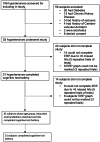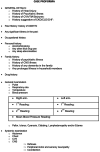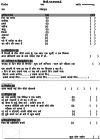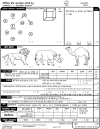Assessment of Cognition in Hypertensives and Normotensives: A Comparative P300 Study
- PMID: 36171857
- PMCID: PMC9508903
- DOI: 10.7759/cureus.28397
Assessment of Cognition in Hypertensives and Normotensives: A Comparative P300 Study
Abstract
Background: Hypertension is an established risk factor for dementia, and the prevalence of hypertension and dementia is rising. Current tests to diagnose cognitive dysfunction at an early stage lack sensitivity and specificity. Recently event-related potentials (ERPs) have gained much attention in diagnosing cognitive dysfunction and are independent of the education status of the subject. This study was done to find any cognitive deficits in the hypertensive population with electrophysiological evidence, which might open the doors for the need to screen the population at an earlier stage so that the population can be prevented from dementia.
Methods: Some 31 middle-aged (18-65 years) hypertensives were compared with 31 age, sex, education, and handedness matched normotensives about cognition by neuropsychometric test battery including Hindi Mini-mental Status Examination (HMSE), Hindi Montreal Cognitive Assessment (MoCA), choice reaction time (CRT), and auditory event-related potentials.
Results: Hypertensives and normotensives differed significantly concerning P300 potentials' latency (Fz and Cz P300 latencies: p-value: 0.001), and this change was correlated well with the duration of diastolic blood pressure (BP) (r-value: 0.670). The remaining tests, HMSE, Hindi MoCA, and CRT, were dependent on the education status of the patient.
Conclusions: The effect of hypertension on cognitive impairment is evident and can be proved early in its pre-clinical stage using ERPs. Early identification can help in specifying high-risk individuals. ERPs have great potential in screening and diagnosing and can also help in assessing cognition as a reliable tool to show the effect of treatments/interventions on cognitive defects.
Keywords: auditory p300; choice reaction time; hypertension; mmse; moca.
Copyright © 2022, Gogisetti et al.
Conflict of interest statement
The authors have declared that no competing interests exist.
Figures













Similar articles
-
Cognitive impairment in Chinese IIDDs revealed by MoCA and P300.Mult Scler Relat Disord. 2017 Aug;16:1-7. doi: 10.1016/j.msard.2017.05.006. Epub 2017 May 19. Mult Scler Relat Disord. 2017. PMID: 28755678
-
Utility of P300 auditory event related potential latency in detecting cognitive dysfunction in growth hormone (GH) deficient patients with Sheehan's syndrome and effects of GH replacement therapy.Eur J Endocrinol. 2004 Feb;150(2):153-9. doi: 10.1530/eje.0.1500153. Eur J Endocrinol. 2004. PMID: 14763913 Clinical Trial.
-
Event-related potentials in the elderly with new mild hypertension.Clin Exp Hypertens. 2000 Aug;22(6):583-93. doi: 10.1081/ceh-100100093. Clin Exp Hypertens. 2000. PMID: 10972163
-
Evaluation of cognitive performance by using P300 auditory event related potentials (ERPs) in patients with growth hormone (GH) deficiency and acromegaly.Growth Horm IGF Res. 2009 Feb;19(1):24-30. doi: 10.1016/j.ghir.2008.05.002. Epub 2008 Jun 24. Growth Horm IGF Res. 2009. PMID: 18567522
-
Is the Montreal Cognitive Assessment (MoCA) test better suited than the Mini-Mental State Examination (MMSE) in mild cognitive impairment (MCI) detection among people aged over 60? Meta-analysis.Psychiatr Pol. 2016 Oct 31;50(5):1039-1052. doi: 10.12740/PP/45368. Psychiatr Pol. 2016. PMID: 27992895 Review. English, Polish.
Cited by
-
Parameters of Auditory Evoked Related Potentials P300 in Disorders of Different Cognitive Function Domains (Visuospatial/Executive and Memory) in Elderly Hypertensive Persons.Diagnostics (Basel). 2023 Apr 30;13(9):1598. doi: 10.3390/diagnostics13091598. Diagnostics (Basel). 2023. PMID: 37174989 Free PMC article.
-
Impact of exercise training on cognitive function in patients with COPD: a systematic review and meta-analysis of randomised controlled trials.Eur Respir Rev. 2025 Feb 5;34(175):240170. doi: 10.1183/16000617.0170-2024. Print 2025 Jan. Eur Respir Rev. 2025. PMID: 39909502 Free PMC article.
-
Evaluation of Event-Related Potentials in Somatic Diseases - Systematic Review.Appl Psychophysiol Biofeedback. 2024 Sep;49(3):331-346. doi: 10.1007/s10484-024-09642-5. Appl Psychophysiol Biofeedback. 2024. PMID: 38564137
References
-
- Incident dementia and blood pressure lowering in the Hypertension in the Very Elderly Trial cognitive function assessment (HYVET-COG): a double-blind, placebo controlled trial. Peters R. Lancet Neurol. 2008;7:683–689. - PubMed
-
- Cognitive function and hypertension. Birns J, Kalra L. J Hum Hypertens. 2009;23:86–96. - PubMed
-
- The age-dependent relation of blood pressure to cognitive function and dementia. Qiu C, Winblad B, Fratiglioni L. Lancet Neurol. 2005;4:487–499. - PubMed
-
- Global burden of hypertension: analysis of worldwide data. Kearney PM, Whelton M, Reynolds K, Muntner P, Whelton PK, He J. Lancet. 2005;365:217–223. - PubMed
LinkOut - more resources
Full Text Sources
Research Materials
Miscellaneous
